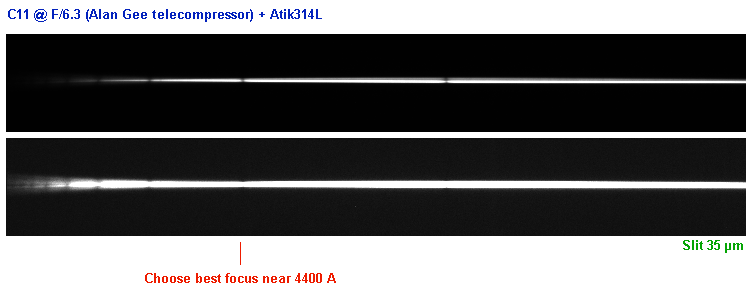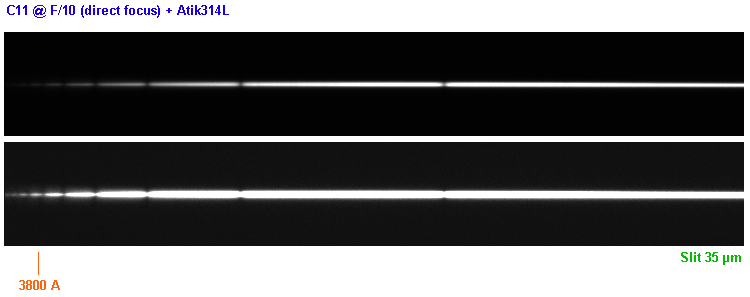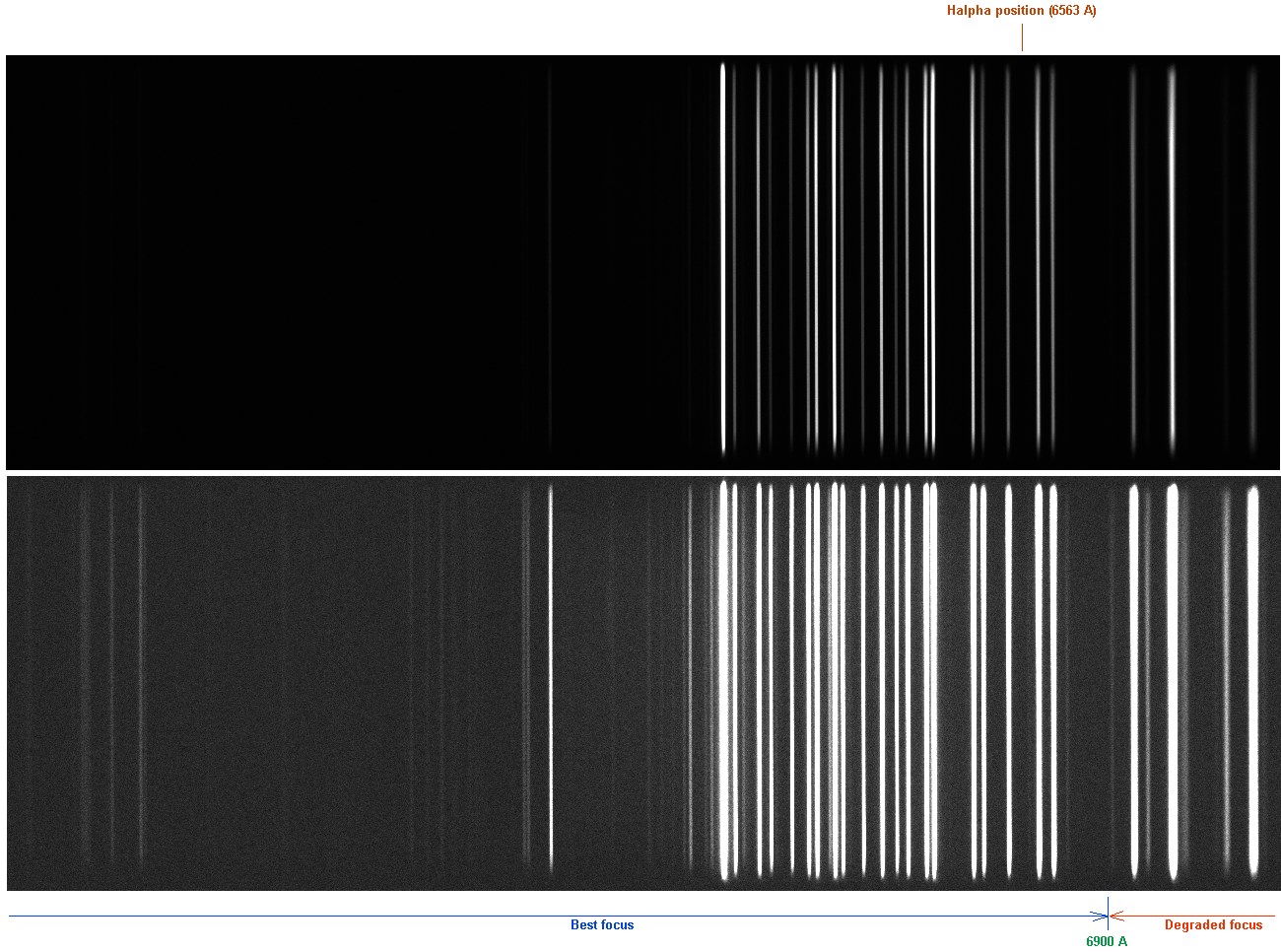Page 1 of 3
Beginning with a Lisa
Posted: Wed Nov 16, 2011 6:20 pm
by Patrick Lailly
A couple of weeks ago, my Lisa caught its first light behind a C8 and in front of an Atik 314L+ camera. At first glance, tuning such an acquisition chain looked straightforward. According to a recent post by Emmanuel Thienpont on Spectro-L, along with the reply by Francois Teyssier, it is not that simple. Indeed, my spectrum of Altair is splitted:

Very similar to the image shown by Emmanuel on Spectro-L:

and far from the "good spectrum" shown by Francois:

I do not know how critical the problem is: obviously, it only affects the very blue part of the spectrum. May be the resulting profile will not be sevely affected. However it may be worth fine tuning the acquisition chain. In my case, I suspect a poor collimation of my telescope. I will look at it in the near future.
Patrick
Re: Beginning with a Lisa
Posted: Wed Nov 16, 2011 11:16 pm
by Christian Buil
The origin of image spliting in extreme blue and UV part of the spectrum is related to unfocused stellar image at the slit entrance because the presence of chromatic aberration. You can see image of telescope central obstruction in some circonstance.
The source of chromatism is double :
- the LISA internal aberration. Remember, the LISA optic is optimized for the wavelength range from 4000 A to 7100 A (for a f/5 equivalent telescope). The image deterioration increase more and more for wavelength shorter than 4000 A.
- the focal reduced added in front the LISA spectrograph is a major source of image quality degradation in the UV part. The majority of focal reducer are simple economic doublet, optimized for the visible part of the spectrum and poor UV quality. Try to remove the focal reducer and take an image for comparison.
Here a demo. First a focal reducer for an equivalent final beam at f/6.3 :

The spectrum quality is fine from 3950 A to 7100 A for scientific analysis.
Now the focal reducer is removed (f/10 input beam) :

The quality is now fine down to 3800 angstroms (!). My LISA spectrograph is not perfectly adjusted by comparison to Emmanuel or Thierry models

Note : the best telescope for LISA is probably a Newton at F/5-F/7 (perfectly achromatic).
A key point is equalization of image sharpness only along the usable spectral range by focusing the star at the entrance slit.
Consider also the quality of slit image on the dectector surface (by adjusting the internal objective). Here a typical example of good image with my setup (internal neon lamp spectrum - 5 seconds exposure - 35 microns slit, the best choice for standard work):

Do not attent to focus the IR part (of low astrophysic interest). Note the very sharp image at Halpha level. Try to reproduce this figure.
Christian B
Re: Beginning with a Lisa
Posted: Thu Nov 17, 2011 1:52 pm
by Rainer Ehlert
Hi Christian,
I say thank you as I am in a comparable situation with my LISA as I am using a 8" RC with a reducer which has 4 optical elements.
Now after reading your posting my question is. What happens if the blue end is like a Fishtail ? Do I get a higher intensity or is the spectrum after analysis the same as if no Fishtail ?
As you seen to have both cases it would be interesting to see both spectrum profiles and so learn the difference.
Thanks and regards Rainer
Re: Beginning with a Lisa
Posted: Thu Nov 17, 2011 4:55 pm
by Francois Teyssier
I am not able to provide answers to the question, however here are some additional food for thought.
My scope is a classical Meade SC 10", not good, not bad.
On the other hand the focal reducer is a beautiful piece of optical : Lumicon giant reducer. Unfortunatly, it is no longer sold. I bought one of the last ones, perharps the last one in an autralian shop, after a long research.

- lumicon.PNG (135.42 KiB) Viewed 28267 times
For my first images with Lisa, the resuls where not so good
Eta Leo (march 2011)
One of my best Images
Beta Orion (october 2011)
The same star (Eta UMa), at two different dates, no change (?) in the tuning :
The second one is lower.
The focalisation is almost the same. I think that seing is different.
Best regards
François Teyssier
Re: Beginning with a Lisa
Posted: Thu Nov 17, 2011 6:29 pm
by Benjamin Mauclaire
Hi Francois,
Perhaps you forgot chromatic effect from atmosphere that makes a vertical spectrum (along the slit) at spectrum's edges.
As you, if LHIRES3 doublet setup is fine, we can obtain spectra with no large fishtail at edges. See HD57682 spectrum taken april 2011from 3800 A to 8800 A (150 g/mm and 27 um slit):

and sharped image:

Christian, with your post, it seems that LISA can work at f/d 10. Is such setup OK for LISA usage? I don't want to change my setup for one spectro usage.
Benji
Re: Beginning with a Lisa
Posted: Thu Nov 17, 2011 9:16 pm
by Francois Teyssier
Hi Rainer,
Could you show us some same samples of your spectra.
I remember you've got good (very) results
François
Re: Beginning with a Lisa
Posted: Fri Nov 18, 2011 2:21 am
by Christian Buil
Hi Benjamin M......
First, Lhires III is a excellent spectrograph but you forget an important point.
The LISA spectrograph collimator focal length is 136 mm. The focal length of the objective lens is 82 mm. So, the internal magnification is 82/136 = 0.60.
If you use a F/10 the telescope, the effective aperture of the system is F/6 (not the Lhires F/10). At the direct focus of a F/10 SCT, LISA is more luminous than LHIRES (for the same telescope).
Now suppose we use a f/6.3 focal reducer (my configuration). The overall aperture ratio is F/3.8. So LISA spectrograph is now a very high efficiency instrument for faint surface objets spectroscopy (for example), much more than Lhires.
LISA and LHIRES III are not the same instruments.
Second, please Benjamin, can you extract the calibrated spectral profile of HD57682, for comparison purpose.
Christian Buil
Re: Beginning with a Lisa
Posted: Fri Nov 18, 2011 12:31 pm
by Robin Leadbeater
Hi Benji,
Hi Francois,
Perhaps you forgot chromatic effect from atmosphere that makes a vertical spectrum (along the slit) at spectrum's edges.
Atmospheric chromatic efects can bend the spectrum into a curve but should not produce a fish tail
As you, if LHIRES3 doublet setup is fine, we can obtain spectra with no large fishtail at edges. See HD57682 spectrum taken april 2011from 3800 A to 8800 A (150 g/mm and 27 um slit):
That is certainly better than I got with the LHIRES but I do not use the 150grating very often. Is that just one image or did you join several together ?
Cheers
Robin
Re: Beginning with a Lisa
Posted: Fri Nov 18, 2011 6:18 pm
by Benjamin Mauclaire
Good evening,
My HD57682 spectrum is a sum of 5x600s exposures. During April, HD57682 is low in the sky so I did such long exposure.
Here is the lines profile corrected from atmopheric absorption:

and the fits file:
http://bmauclaire.free.fr/astronomie/sp ... 20_895.fit
HD57682 is one of the five Be-Oe stars discovered with intense magnetic field (about 1600 Gauss) in 2009.
Christian, thanks for your explanantions.
Focal reducer does absorbe a fraction of light. Internal LISA tripplet does it too.
With that facts, what is the expected total magnitude gain with LISA?
Benji
Re: Beginning with a Lisa
Posted: Fri Nov 18, 2011 7:53 pm
by Rainer Ehlert
Christian Buil wrote:Hi Benjamin M......
First, Lhires III is a excellent spectrograph but you forget an important point.
The LISA spectrograph collimator focal length is 136 mm. The focal length of the objective lens is 82 mm. So, the internal magnification is 82/136 = 0.60.
If you use a F/10 the telescope, the effective aperture of the system is F/6 (not the Lhires F/10). At the direct focus of a F/10 SCT, LISA is more luminous than LHIRES (for the same telescope).
Now suppose we use a f/6.3 focal reducer (my configuration). The overall aperture ratio is F/3.8. So LISA spectrograph is now a very high efficiency instrument for faint surface objets spectroscopy (for example), much more than Lhires.
LISA and LHIRES III are not the same instruments.
Second, please Benjamin, can you extract the calibrated spectral profile of HD57682, for comparison purpose.
Christian Buil
Hi,
This is an interesting information.
I always thought that the info " LISA is optimized for f/5 ... " ment that I have to use a f/5 telescope but from what I understand above it is not necessary ¿ or am I understanding the post wrong ?
If that is OK, eg using a f/8 telescope, then I could have saved a lot of money by making custom adapters and I do not know what else

Thanks for explaining me this a bit further

Another interesting comparison would be to see the analysis of the same star with and without the fishtail in the blue












